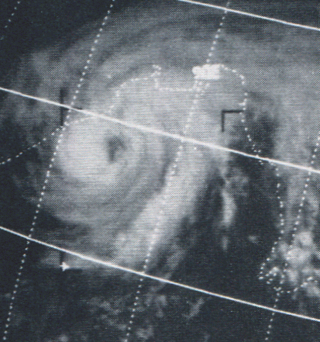
Odisha, formerly Orissa, is an Indian state located in Eastern India. It is the 8th-largest state by area, and the 11th-largest by population, with over 41 million inhabitants. The state also has the third-largest population of Scheduled Tribes in India. It neighbours the states of Jharkhand and West Bengal to the north, Chhattisgarh to the west, and Andhra Pradesh to the south. Odisha has a coastline of 485 kilometres (301 mi) along the Bay of Bengal in Indian Ocean. The region is also known as Utkala and is mentioned by this name in India's national anthem, "Jana Gana Mana". The language of Odisha is Odia, which is one of the Classical Languages of India.

The 1999 Odisha cyclone was the most intense recorded tropical cyclone in the North Indian Ocean and among the most destructive in the region. The 1999 Odisha cyclone organized into a tropical depression in the Andaman Sea on 25 October, though its origins could be traced back to an area of convection in the Sulu Sea four days prior. The disturbance gradually strengthened as it took a west-northwesterly path, reaching cyclonic storm strength the next day. Aided by highly favorable conditions, the storm rapidly intensified, attaining super cyclonic storm intensity on 28 October, before peaking on the next day with winds of 260 km/h (160 mph) and a record-low pressure of 912 mbar. The storm maintained this intensity as it made landfall on Odisha on 29 October. The cyclone steadily weakened due to persistent land interaction and dry air, remaining quasi-stationary for two days before slowly drifting offshore as a much weaker system; the storm dissipated on 4 November over the Bay of Bengal.

Natural catastrophe in India, many of them related to the climate of India, cause massive losses of life and property. Droughts, flash floods, cyclones, avalanches, landslides brought by torrential rains, and snowstorms pose the greatest threats. A natural disaster might be caused by earthquakes, flooding, volcanic eruption, landslides, hurricanes etc. In order to be classified as a disaster, it will need to have a profound environmental effect and/or human loss and frequently incurs a financial loss. Other dangers include frequent summer dust storms, which usually track from north to south; they cause extensive property damage in North India and deposit large amounts of dust and dirt from arid regions. Hail is also common in parts of India, causing severe damage to standing crops such as rice and wheat and many more crops and effects many people.

Bharat Sevashram Sangha is a Hindu religious and spiritual organisation focused on humanitarian work. It was founded in 1917 by the illustrious patriot saint Acharya Srimat Swami Pranavananda Maharaj. It is purely a philanthropic and charitable organization with non-sectarian, non-communal and non-political character and outlook. The headquarter of the Sangha is situated in Kolkata, West Bengal with more than three hundreds of branches in India and also in other countries including the United Kingdom, United States, Guyana, Trinidad and Tobago, Canada, Fiji and Bangladesh. It has initiated several missions to African countries, Malaysia, and Indonesia; monks from the Sangha have accompanied United Nations delegations to Syria and Lebanon.

The Odisha Police abbreviated as either OP or OPS, is the law enforcement agency for the state of Odisha in India. It is headquartered in Cuttack, the former capital of Odisha. The Odisha Police is headed by a Director General of Police, currently Sunil Kumar Bansal, IPS and falls under the purview of the state's Home Department of the Government of Odisha. The sanctioned personnel strength of Odisha Police is 72,145; comprising women as one-third of it total sanctioned strength in the directly recruited posts of civil constable, sub-inspector and deputy superintendent of police. This feat makes it one of the foremost in that aspect among the police services of India.

Odisha TV or OTV is an Odia Indian Cable Television station. It is owned by the Bhubaneswar-based Odisha Television Network. It was started and promoted by Jagi Mangat Panda. Odisha Television (OTV) is the first private Electronic Media in the state of Odisha.
The National Disaster Response Force (NDRF) is an Indian specialized force constituted "for the purpose of special response to a threatening disaster situation or disaster" under the Disaster Management Act, 2005. The "Apex Body for Disaster Management" in India is the National Disaster Management Authority (NDMA). The Chairman of the NDMA is the Prime Minister.
On 30 April 2012, a ferry carrying about 350 passengers capsized in the Brahmaputra River in the Dhubri district of Assam in Northeast India. The disaster killed at least 103 people.

Cyclonic Storm Viyaru, operationally known as Cyclonic Storm Mahasen, was a relatively weak tropical cyclone that caused loss of life across six countries in Southern and Southeastern Asia. Originating from an area of low pressure over the southern Bay of Bengal in early May 2013, Viyaru slowly consolidated into a depression on May 10. The depression gained forward momentum and attained gale-force winds on May 11 and was designated as Cyclonic Storm Viyaru, the first named storm of the season. Owing to adverse atmospheric conditions, the depression struggled to maintain organized convection as it moved closer to eastern India. On May 14, the exposed circulation of Viyaru turned northeastward. The following day, conditions again allowed for the storm to intensify. Early on May 16, the cyclone attained its peak intensity with winds of 85 km/h (55 mph) and a barometric pressure of 990 mbar. Shortly thereafter Viyaru made landfall near Chittagong, Bangladesh. On May 17, it moved over the eastern Indian state of Nagaland.

Extremely Severe Cyclonic Storm Phailin was one of the most intense tropical cyclones to make landfall in India since the 1999 Odisha cyclone. The system was first noted as a tropical depression on October 4, 2013, within the Gulf of Thailand, to the west of Phnom Penh in Cambodia. Over the next few days, it moved westwards within an area of low to moderate vertical wind shear, before as it passed over the Malay Peninsula, it moved out of the Western Pacific Basin on October 6. It emerged into the Andaman Sea during the next day and moved west-northwest into an improving environment for further development before the system was named Phailin on October 9, after it had developed into a cyclonic storm and passed over the Andaman and Nicobar Islands into the Bay of Bengal.

The 1971 Odisha cyclone was a devastating tropical cyclone that struck the Indian state of Odisha on October 29, 1971. The cyclone also affected the Indian state of West Bengal as well as East Pakistan, which had been devastated by the 1970 Bhola cyclone just less than a year prior and was in the middle of Bangladesh Liberation War.

In the wake of heavy monsoon rain and flash floods in Jammu and Kashmir, the Indian Armed Forces were deployed in increasing numbers starting 2 September 2014 to conduct search, rescue, relief, relocation, humanitarian assistance and rehabilitation missions in Jammu and Kashmir. By 18 September, over 298,514 people were rescued from the various parts of Jammu and Kashmir by the Armed forces. The Jammu and Kashmir floods, the worst in a century according to Omar Abdullah, the Chief Minister of Jammu and Kashmir, paralyzed the state government. Omar Abdullah, responding to public criticism, told the media "I had no government" in the first few days following the floods, as "My secretariat, the police headquarters, the control room, fire services, hospitals, all the infrastructure was underwater." Adding "I had no cell phone and no connectivity. I am now starting to track down ministers and officers." The Jammu and Kashmir floods of 2014 have been blamed on heavy rainfall, about 8 inches (200mm) on 4 September alone, on climate change, unplanned and uncontrolled development, encroachment of river banks, lakes, ponds, and massive loss of wet lands, absence of local government flood forecasting system, and poor governance. The Armed Forces humanitarian assistance mission in response to the floods was named Mission Sahayata (assistances). Northern Command's humanitarian assistance to Civil authorities was named 'Operation Megh Rahat'. The Indian Army, Air Force, and the Navy, committed large resources to the assistance mission including over 30,000 troops, 15 engineer task forces, 84 Indian Air Force and Army Aviation Corps fixed wing transport aircraft and helicopters, naval commandos and rescue specialists, and Base Hospital, four field hospitals, over 106 medical detachments. "Operation Megh Rahat", ended on 19 September 2014, but "Operation Sadbhavna", the relief and medical assistance support, according to government press release, will continue in "close synergy with the civil administration and the police".

Extremely Severe Cyclonic Storm Hudhud was a strong tropical cyclone that caused extensive damage and loss of life in eastern India and Nepal during October 2014. Hudhud originated from a low-pressure system that formed under the influence of an upper-air cyclonic circulation in the Andaman Sea on October 6. Hudhud intensified into a cyclonic storm on October 8 and as a Severe Cyclonic Storm on October 9. Hudhud underwent rapid deepening in the following days and was classified as a Very Severe Cyclonic Storm by the IMD. Shortly before landfall near Visakhapatnam, Andhra Pradesh, on October 12, Hudhud reached its peak strength with three-minute wind speeds of 185 km/h (115 mph) and a minimum central pressure of 960 mbar (28.35 inHg). The system then drifted northwards towards Uttar Pradesh and Nepal, causing widespread rains in both areas and heavy snowfall in the latter.

The 1995 India cyclone was a tropical cyclone that struck southeastern India which later spawned a rare snowstorm in Nepal, triggering the deadliest mountain trekking incident in the country's history in November 1995. The storm originated from the monsoon trough on November 7 in the Bay of Bengal, east of India, becoming the penultimate storm of the 1995 North Indian Ocean cyclone season. Moving northwestward, the system gradually intensified while moving toward land, eventually developing an eye in the middle of the convection. Reaching peak winds of at least 120 km/h (75 mph), the India Meteorological Department (IMD) classified the system as a very severe cyclonic storm on November 8, in line with intensity estimates from the American-based Joint Typhoon Warning Center (JTWC). On November 9, the cyclone made landfall near the border of Andhra Pradesh and Orissa. A typical for most November storms, the system continued to the north and dissipated over Nepal on November 11.

Odisha State Disaster Management Authority is an agency of the Department of Revenue & Disaster Management whose primary purpose is to carry out responses to natural or man-made disasters and for capacity-building in disaster resiliency and crisis response. It was established as the Odisha State Disaster Mitigation Authority by a resolution of the Department of Finance of the Government of Odisha on 28 December 1999, as a response to the death toll and damage caused by a 1999 supercyclone. The chief secretary of Government of Odisha is the ex-officio chairperson of the governing body of the authority.
The 2019 Indian floods were a series of floods that affected over thirteen states in late July and early August 2019, due to excessive rains. At least 200 people died and about a million people were displaced. Karnataka and Maharashtra were the most severely affected states. People died but many were rescued with the help of the Indian Navy.

Super Cyclonic Storm Amphan was an extremely powerful and catastrophic tropical cyclone that caused widespread damage in Eastern India, specifically in West Bengal and Odisha, and in Bangladesh, in May 2020. It was the strongest tropical cyclone to strike the Ganges Delta. It was also the fourth super cyclone that hit West Bengal and Kolkata since 2015 as well as being one of the strongest storms to impact the area. Causing over US$13 billion of damage, Amphan is also the costliest cyclone ever recorded in the North Indian Ocean, surpassing the record held by Cyclone Nargis of 2008.

Very Severe Cyclonic Storm Titli was a deadly and destructive tropical cyclone that caused extensive damage to Eastern India in October 2018. Titli was the twelfth depression and fifth named storm to form in the 2018 North Indian Ocean cyclone season. Titli originated from a low pressure area in the Andaman Sea on October 7. With warm sea surface temperatures and low wind shear, the low developed into a depression on October 8 in the central Bay of Bengal. It was tracked and followed by the India Meteorological Department (IMD), which also issued warnings and notices for the public. Titli continued to intensify at it moved toward the southeast Indian coast, becoming a very severe cyclonic storm, equivalent to a minimal hurricane on the Saffir–Simpson scale. It attained the intensity at the same time Cyclone Luban in the Arabian Sea was at the same intensity, marking the first instance since 1977 of simultaneous storms. The IMD estimated peak winds of 150 km/h (95 mph), while the American-based Joint Typhoon Warning Center (JTWC) estimated peak winds of 195 km/h (120 mph). Late on October 10, Titli made landfall in Andhra Pradesh, and it quickly weakened over land as it turned to the northeast. It degenerated into a remnant low on October 12.

Cyclone Amphan was the costliest tropical cyclone ever recorded in India and the North Indian Ocean, and the strongest cyclone ever since the 1999 Odisha Cyclone. It was the first storm, and strongest of the historic 2020 North Indian Ocean cyclone season, the costliest recorded cyclone season. It made landfall in West Bengal with 100 mph winds. Within India, the storm killed 98 people, and caused $13.8 billion. Amphan produced extremely high winds that ripped roofs off houses and uprooted trees, and storm surges of 15 ft (4.6 m) in areas like Digha, West Bengal.

Very Severe Cyclonic Storm Yaas was a relatively strong and very damaging tropical cyclone that made landfall in Odisha and brought significant impacts to West Bengal during late May 2021. The second cyclonic storm, second severe cyclonic storm, and second very severe cyclonic storm of the 2021 North Indian Ocean cyclone season, Yaas formed from a tropical disturbance that the Indian Meteorological Department first monitored on May 23. Conditions in the basin favored development as the system became a deep depression later that day, before intensifying into a cyclonic storm on the next day, receiving the name Yaas. The system further intensified as it turned to the northeast, becoming a severe cyclonic storm on May 24 despite moderate wind shear. Marginally favorable conditions further continued as Yaas accelerated northeastward, strengthening to a Category 1-equivalent tropical cyclone and to a very severe cyclonic storm on May 25. Yaas crossed the northern Odisha coast around 20 km south of Balasore at its peak intensity as a very severe cyclonic storm on May 26. Upon landfall, the JTWC and IMD issued their final advisories as Yaas further weakened inland while turning north-northwestwards.

















